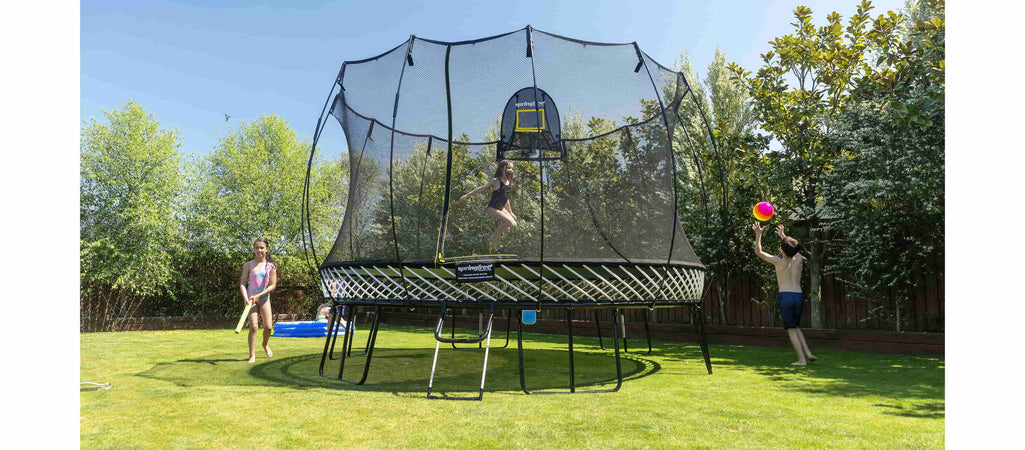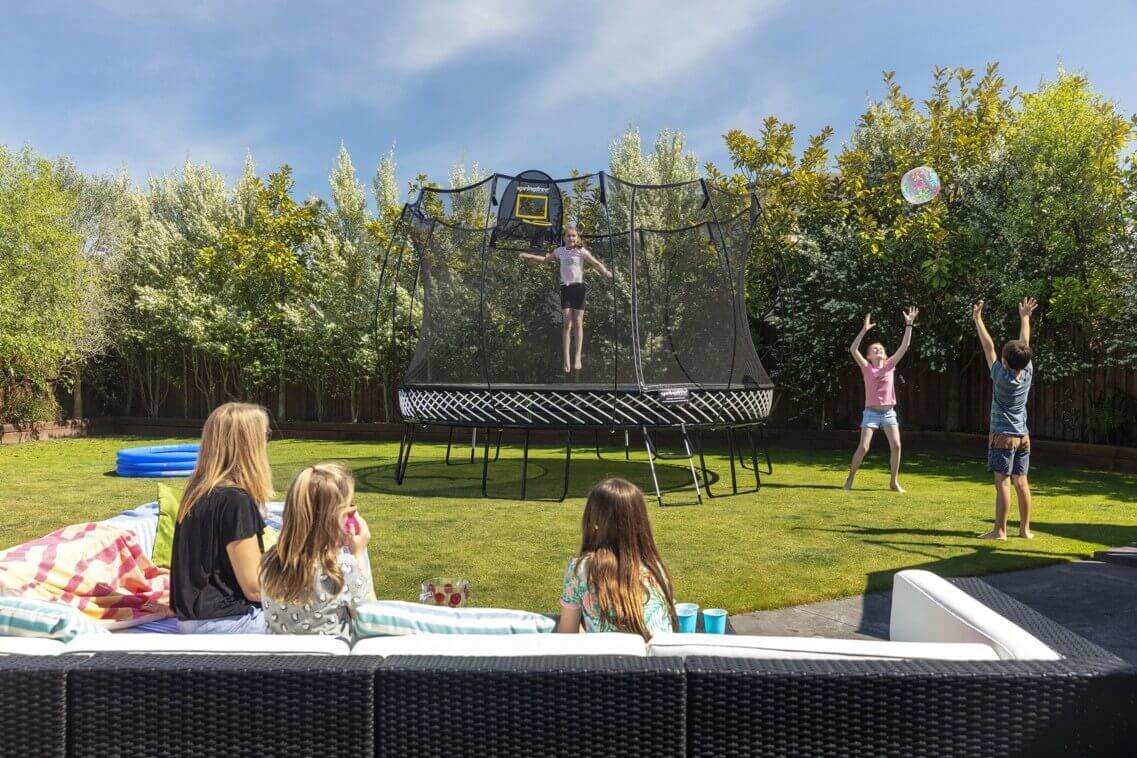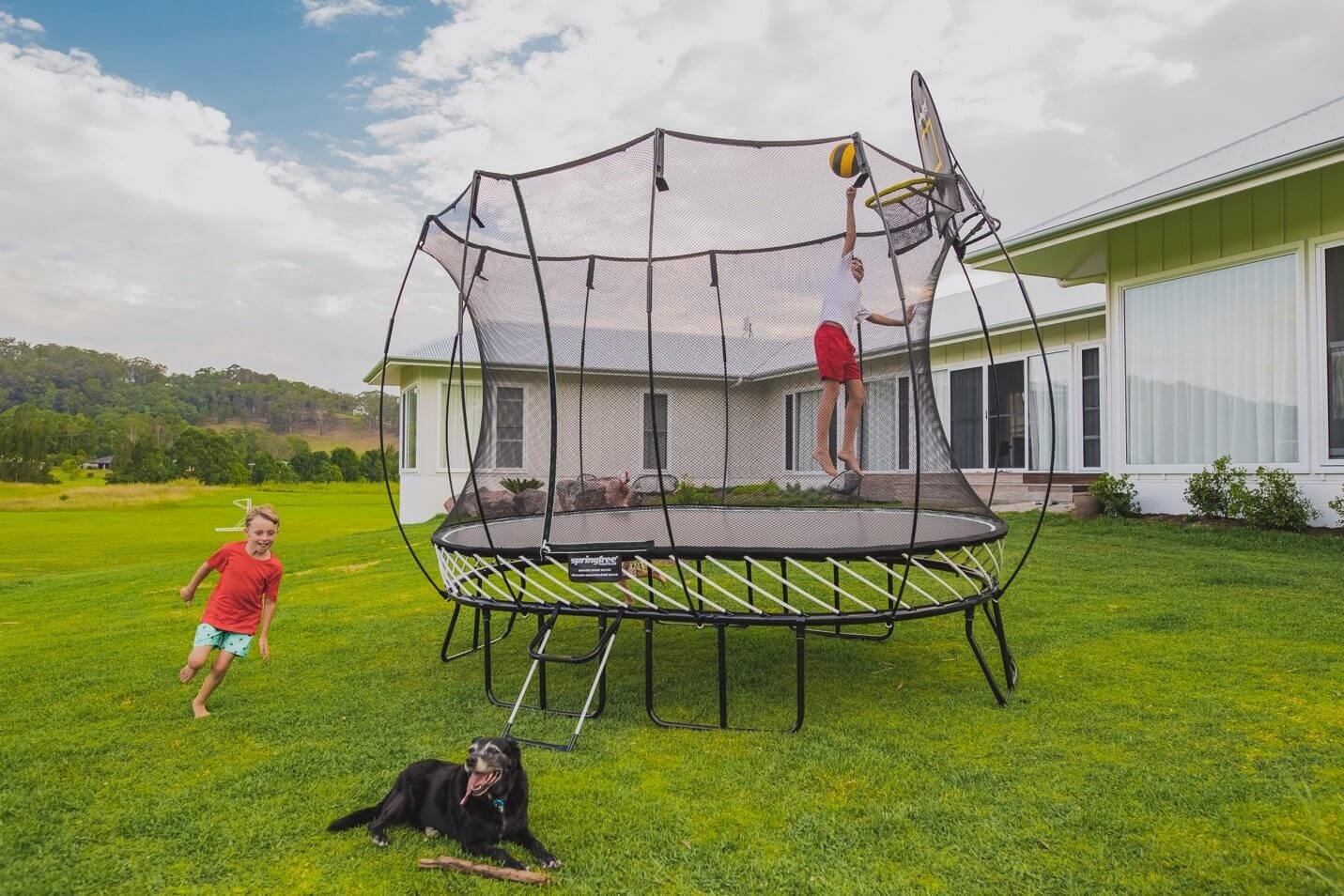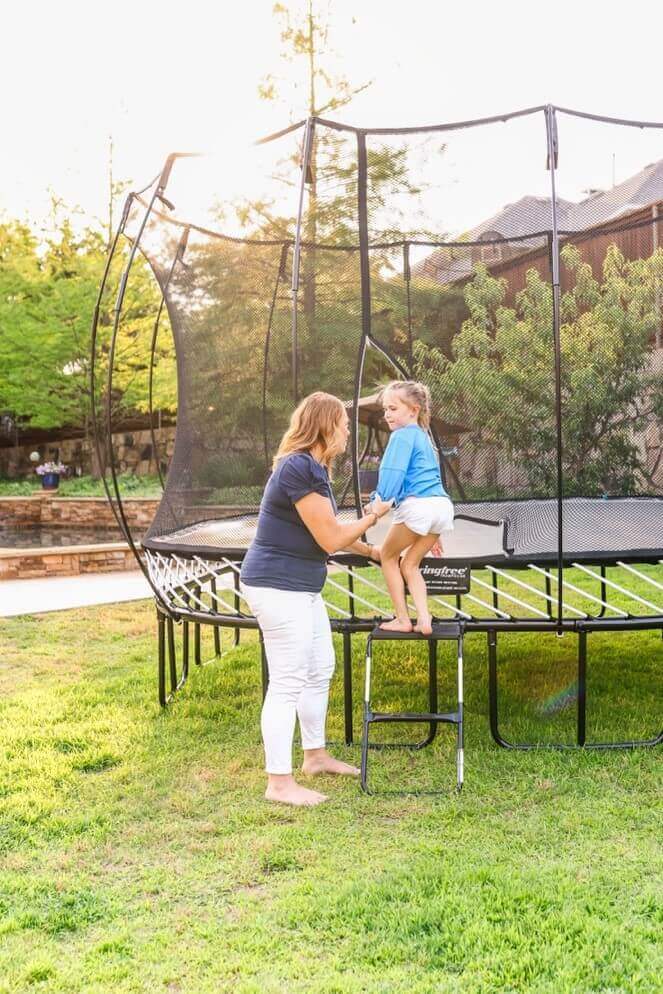10 Rules to Avoid Trampoline Injuries | From the Experts
Discover how you can use a trampoline safely and minimise your risk of injury with these 10 safety rules from the experts at Springfree Trampoline!
min read

You’ve probably heard this oft-recited statement before: “Trampolines are too dangerous!”
Here’s the truth within that statement: Yes, trampolines can be dangerous IF you don’t use them properly.
That “IF” is the key, because if you use a trampoline the right way, it can provide you and your family with joyful moments and everlasting memories without compromising your safety.
But sadly, many people either don’t follow or don’t know about the basic trampoline safety rules that could prevent a lot of the trampoline injuries that occur.
To help you and your loved ones avoid a trampoline accident, we are going to use our standing as the inventors of the safest trampoline (Springfree Trampoline) to provide you with 10 ground rules that, if followed, will significantly decrease your chances of experiencing a trampoline injury.
Trampoline Injury Statistics
Before getting to the safety rules, we want to provide you with some data about trampoline injuries, so you’re fully informed on the subject.
As the data demonstrates, trampolines can be dangerous if not used correctly. Around 100,000 go to the emergency room every year for a trampoline injury, according to Policygenius.
Of the trampoline injuries that happen each year, most of them are sustained by children, with the vast majority occurring by children between the ages of 5 and 14, according to OrthoInfo.
Trampolines are undoubtedly safer than they were a couple of decades ago, with most trampolines nowadays having enclosure nets and safety padding over the springs.
But trampolines, particularly ones that use cheaper materials, still pose safety hazards that need to be considered before purchasing one. (Check out our article summarising the seven things to consider when buying a trampoline if you haven’t purchased one yet!)
There are multiple ways to get injured on a trampoline, but the most common ones are:
-
Multiple people colliding while jumping on the trampoline at the same time.
-
Falling on the trampoline mat, frame or springs without adequate padding.
-
Performing flips or other tricks and landing awkwardly.
-
Falling off or through the trampoline and to the ground.
These statistics may alarm you a bit about the safety of trampolines. Rest assured, in the next section, we’re going to give you 10 rules to follow so you can rest assured that you are lowering your chances of a trampoline injury.
10 Safety Rules for Trampolines
Here are 10 rules to implement in your backyard so you and your kids are as protected as possible from sustaining a trampoline injury:
1. One Jumper at a Time
Here is a jarring statistic, courtesy of Complete Care: About 75% of trampoline injuries occur when more than one person is jumping on the trampoline.
It makes sense, then, that our first trampoline safety rule is to mandate that only one person can jump at a time.
If multiple people are jumping on the trampoline at a time, it increases the risk of suffering an injury from a collision. Statistics show that with more than one simultaneous user, the smaller/lighter of the two is almost always the one sustaining an injury.
If you go by the data, you are cutting down your chances of suffering a trampoline injury by 75% if you strictly adhere to the “One Jumper at a Time” Rule!

2. No Flipping
Another area where injuries can occur on a trampoline is by flipping or jumping unnaturally.
Doing a flip and landing on your head or neck can cause serious injury. That’s why, unless you’re a trained jumper, you shouldn’t do any type of flips or stunts.
3. Avoid Roughhousing
If there’s a situation where there are multiple jumpers on the trampoline (we strongly recommend one jumper at a time!), roughhousing of any kind should be prohibited.
Trampolines are not wrestling rings: If you roughhouse on a trampoline, the chance of injury will naturally increase.
4. No Pets
At some point, the resident dog or cat may see the trampoline and decide it’s their turn to get a good jump in.
While they surely mean well, pets can cause damage to the trampoline, mainly by scratching the jumping mat or tearing up the net.
Damage to the mat or net can be a significant safety hazard and lead to falling off the trampoline, which comprises around 40% of all trampoline-related injuries.
Tip: Make sure the enclosure net is zipped up at all times, so pets don’t sneak onto the trampoline!

5. Clean Your Trampoline
Regularly cleaning your trampoline enhances the safety of your trampoline for a couple of reasons:
-
One, cleaning keeps the trampoline in good shape and free from rust—which can weaken the trampoline’s structure and make it susceptible to breaking while somebody is jumping on it.
-
Two, regularly cleaning a trampoline removes foreign objects from the trampoline’s surface. New objects can be another potential “hard surface” that may result in injury.
Check out our article on how to clean a trampoline for exact steps and tips when cleaning your trampoline!
6. Supervise When Necessary
Adult supervision is a good way to stop a trampoline accident before it happens.
Children between the ages of 6 and 12 are recommended to have adult supervision while jumping, and nobody under six years old should use an outdoor trampoline, according to the American Academy of Orthopedic Surgeons.
If you go back to the statistic in the previous section about child trampoline injuries, most trampoline injuries are suffered by young children around the 5-14 age range. Until you can fully trust your children on a trampoline, supervision is highly suggested to avoid injuries.
7. Underneath the Trampoline Is Off Limits
Nobody, under any circumstance, should be under the trampoline while another person is jumping.
This includes children, adults and pets. Being underneath a trampoline while someone is jumping is, for obvious reasons, a safety hazard and should be avoided.
8. Stay Centered
The safest spot on a trampoline is right in the center, and the more you deviate from the middle, the more risk you have of falling off the trampoline.
Although some trampolines have flexible nets capable of handling a jumpers’ force (like our Springfree Trampolines), cheaper trampolines with poor netting may not be able to hold up as well when jumped into.
Furthermore, on spring-based trampolines, the closer you are to the edges, the closer you are to the springs, which could result in a pinching injury—especially if the springs are located within the enclosure netting.
9. Enter and Exit Safely
Another key to ensuring that your jumpers are safe is to make sure they are entering and exiting the trampoline properly.
This is especially the case if you have younger children, as they may be more likely to fall while entering or exiting the trampoline.
You may want to physically help your child get on and off the trampoline until you trust that they can do it on their own.
Most trampolines will have an enclosure that zips open and closed to allow access: Make sure the zipper is closed at all times while jumping on the trampoline.
Tip: If you’re worried about your children entering/exiting the trampoline, consider buying a trampoline ladder for easier access.

10. Set Expectations
The 10th and final rule? Talk through the first nine rules and set clear expectations that they are to be followed at all times.
Discuss how important these trampoline safety rules are and convey to them how risky trampolines can be if not used correctly. This might seem like a redundant rule, but it sets a precedent that must be adhered to if trampoline access is to be allowed.
Need a Safer Trampoline for Your Backyard?
Trampolines can be dangerous: There’s no denying it. But as long as you follow the 10 safety rules discussed in this article, you will greatly mitigate the chances of suffering a trampoline injury and can rest easy knowing that your kids are safe while jumping.
There’s also one more major decision you can make to significantly decrease your chance of a trampoline injury: Buy a safer, high-quality, trampoline.
At Springfree Trampoline, we have crafted a springless trampoline that eliminates 90% of product-related injuries, with trampoline safety features such as:
-
The use of flexible composite rods, or mat rods, instead of metal springs that can cause pinching injuries.
-
A FlexiNet that cushions wayward jumpers and “flexes” to prevent falling injuries.
-
A hidden frame that is positioned below the jumping surface, making it impossible to fall on while jumping.
-
A SoftEdge Mat that is 30 times more shock absorbent than the safety pads on a spring trampoline and eliminates hard edges around the jumping surface—another common injury point on traditional trampolines.
-
Pliable enclosure rods that replace the need for hard metal poles that can cause impact injuries to the jumper.
Springfree Trampolines are not a fit for everybody. They are premium trampolines and are priced as such ($999-$2,999). However, if you don’t already have a trampoline or are looking to replace your current one, a Springfree Trampoline will be the safest trampoline you will find on the market and could be worth investigating further.

